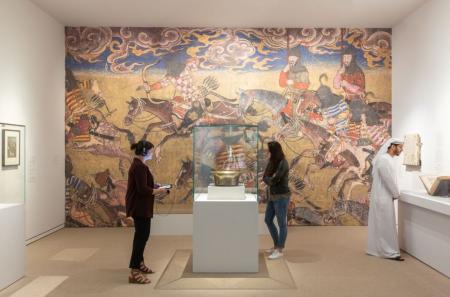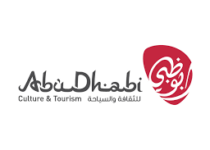The opening of the exhibition was inaugurated by HE Mohamed Khalifa Al Mubarak – Chairman of Department of Culture and Tourism – Abu Dhabi in the attendance of HE Mohammad Ali Al Shorafa Al Hammadi – Chairman of Department of Economic Development, Manuel Rabaté, Director of Louvre Abu Dhabi, Jean-Luc Martinez, President Director, Musée du Louvre, Séverine Lepape, Director of musée de Cluny, Hervé Barbaret, CEO of Agence France-Muséums, Dr. Souraya Noujaim, Scientific, Curatorial & Collections Management Director at Louvre Abu Dhabi, Marwa Al Menhali, Business Support Director at Louvre Abu Dhabi, Dr. Elisabeth Taburet-Delahaye, former Director of Musée de Cluny, musée national du Moyen Âge, Dr. Carine Juvin, Curator at the Department of Islamic Art at Musée du Louvre, Michel Huynh, Head Curator at Musée de Cluny, Musée national du Moyen Âge.
Abu Dhabi: Opening to the public this Wednesday, Louvre Abu Dhabi’s latest international exhibition, Furusiyya: The Art of Chivalry between East and West (19 February – 30 May 2020), will take visitors on a journey through the culture of knights in the Middle Ages, from Christian Europe to Islamic lands in the Middle and Near East. Through more than 130 artefacts, the exhibition will showcase how the emergence of knights as a social class, their art of war as well as their favourite pastimes has manifested throughout the visual culture of the Middle Ages.
Spanning the early 11th to the 16th centuries, the exhibition features objects ranging from arms and armour, written and illustrated treatises and manuscripts, to heraldic and decorative objects. Alongside a historic account and comparative study between knightly culture in East and West throughout the Middle Ages, Furusiyya: The Art of Chivalry between East and West will also bring to light knightly values, namely courage, bravery, honour and generosity – as well as the parallels between these across both cultures.
Manuel Rabaté, Director of Louvre Abu Dhabi commented: “The image of the warrior mounted on a horse or chevalier, is a visual that transcends history and civilisations. With Abu Dhabi acting as a gateway between East and West, Louvre Abu Dhabi is the ideal museum for this comparative study. The exhibition speaks to our global aspiration, while building a strong connection to the region. Our first international exhibition to open this year, Furusiyya: The Art of Chivalry between East and West is part of our current cultural season Changing Societies, and we are incredibly grateful to our partners from across the world, without whom this extraordinary showcase would not have been possible”.
Furusiyya: The Art of Chivalry between East and West is held in partnership with Musée de Cluny, musée national du Moyen Âge in Paris, and Agence France-Muséums which produced this exhibition. The exhibition is curated by Chief Curator Dr. Elisabeth Taburet-Delahaye, former Director of Musée de Cluny, musée national du Moyen Âge, alongside Co-Curators Dr. Carine Juvin, Curator of the Department of Islamic Art at Musée du Louvre and Michel Huynh, Head Curator at Musée de Cluny, musée national du Moyen Âge.
Dr. Souraya Noujaim, Scientific, Curatorial and Collections Management Director at Louvre Abu Dhabi added: “Born out of comparable values – courage, honour, discipline, and faith – both furūsiyya and Western chivalry required equivalent skills, at once physical, sporting, religious, and intellectual. The visitors can engage with a cross-cultural comparison of the artistic manifestations of the life of knights, a group that was emblematic of medieval civilisation. Beyond war and battle, the exhibition sets out to shed light on the development of a chivalric culture in relation to the mutations of medieval society, through literature, music and the arts, making for an intellectually engaging and visually captivating exhibition.”
Séverine Lepape, Director of musée de Cluny added: “Through an extraordinary array of different objects related to the social class of the knights in Medieval times, this exhibition showcases chivalric culture and its ideological values. It will allow visitors to gain insights into the way of life of a group that played a key role in the society of the Middle Ages, both in the East and West. In this, it fits perfectly into the scientific approach of Musée de Cluny, which wishes to make the medieval world better known in all its components.”
Through a strongly immersive scenography designed by Vincen Cornu Architecte, the exhibition unfolds across three main chapters – Riding, Fighting, and the Life of a Knight, all highlighting different aspects of this particular social class. Introducing the visitor to the many similarities between the Islamic East and Christian West, the showcase begins with two monumental horse armours – Louvre Abu Dhabi’s spectacular Ottoman Horse Armour from the late 15th century, installed alongside a European Horse and Knight Armour from the first quarter of the 16th century, on loan from Musée de l’armée, both showcasing the relationship between the rider and his horse, skill and decoration, and majesty and brute strength.
In the first part of the exhibition, visitors will understand the development of this particular social class, manifested through art, artefacts and archaeological remnants. The roots of furusiyya in the East and chivalry in the West are emblematic of historic changes throughout late antiquity. A beautiful example of this time is Plate with a Sasanian King Hunting Rams (Iran, mid-5th-6th century), which shows a Sasanian Royal, mounted on a horse, with armour resembling a knight. Meanwhile in the West, the disintegration of the Roman Empire led to the emergence of the social class of the knights, sharing Eastern values of the devotion to God, visualised in illuminated manuscripts such as the History of the Holy Grail (France, first half of the 14th century).
The showcase then invites to discover artistic and creative exchanges between furusiyya and chivalry evident in the signs and symbols of knightly culture. In the West, heraldry and coat of arms were used as a form of social distinction. Adopting this same practice, Eastern heraldry often reinterpreted Western symbols, such as the French fleur-de-lis, used by several sultans in the 14th century, and whose name in Arabic – faransiyya – indicates its association with the Franks.
The second chapter of the exhibition, through illuminated treatises, weapons and armoury, examines the techniques and education around fighting in East and West. Equipment, one of the main characteristics of a knight, demonstrates interesting commonalities between these two cultures. A Sabre Suspension Belt (Iran, 14th century), bears in Arabic the inscription There is no God but God, all command is His. Likewise, several European shields are adorned with religious motifs, such as David’s fight against Goliath or Saint George Slaying the Dragon (Czech Republic, mid-15th century).
The show also presents objects related to historic meeting points between Christian and Islamic troops, such as the Reconquista in Spain or – more prominently – the Crusades, which led to a cultural exchange as well as increased creative output, seen in chronicles, poems and romance texts from the time. Works such as The Romance of Godfrey of Bouillon and Saladin (France, 14th century) offer fist-hand accounts of the exchanges, confrontations and divisions between these two different cultures.
The final chapter of the exhibition explores knightly pastimes related to combat, and the arts of chivalric cultures. In both Eastern and Western cultures, knights trained and perfected their horsemanship through games and exercise. As a result, pastimes such as polo, hunting, and – to practice strategic thinking – chess, emerged.
The impact of what this exhibition focuses on has remained relevant throughout history. Knightly culture and courtly tales have echoed across centuries and artistic production. From French Orientalist paintings, to Richard Wagner’s Tristan and Isolde to Monty Python’s Holy Grail, these cultural icons find their roots at the same source – chivalry and furusiyya.
A talk led by the three curators of the exhibition will delve into the history of chivalry from historical facts to myths and legends, and include fascinating stories from medieval history’s most loved characters and the continued fascination with heroism in today’s contemporary culture. The talk will take place in the Auditorium on 18th February at 5pm. Access is free, with recommended reservation.
The exhibition will also be accompanied by an extensive cultural programme, curated by Ruth MacKenzie, looking at contemporary culture through the lens of medieval traditions and vice versa.
The work of Egyptian contemporary artist Wael Shawky explores the Crusades from the Arab point of view. Interrogating traditional historical narratives, as presented in Amin Maalouf’s book The Crusades Through Arab Eyes, this large-scale musical theatre performance La Chanson de Roland (The Song of Roland) is based on a French epic poem from the 11th or 12th century France, glorifying the reign and conquests of Emperor Charlemagne and his nephew Roland. The work is staged by over 20 fidjeri singers and musicians from the UAE and Bahrain, performing in the traditional style of Arabian Gulf pearl divers. Performances will take place in the Auditorium Plaza on 26 and 27 February at 8pm. Tickets are for 150 AED (including VAT) and are available online.
A full family weekend will plunge visitors in the medieval times, with activations in the Park, under the Dome, film screenings, parades of knights, workshops and much more. Families will travel back in time to discover the fascinating stories from ancient knights and female warriors, and to get creative by making their own armour fit for the battlefield and enjoy pony rides in the park. They will also get the chance to spot police horse patrols dressed in their traditional attire and learn about the history of Abu Dhabi Police Calvary. Participation is free and the activities will take place between 28 and 29 February from 3 – 6pm.
The renowned Trio Joubran has become eponymous with the oud, or Arabic lute. Coming from a long line of luthiers, the trio innovates in their performance and their instruments come together as three soloists with one single voice. Their performance The Long March will be performed at the museum’s Auditorium Plaza on 26 March at 8pm. Tickets are for 150 AED (including VAT) and are available online. In addition, Trio Joubran will host a talk on Chivalry and Medieval Music, discussing the lute tradition, playing and evolution, alongside Amr Fawzi, the oud maker from Bait Al Oud, on 24 March at 6pm. A masterclass will be hosted by Adnan and Samir Joubran working in public with Bair Al Oud students and graduates on 25 March from 2pm to 5pm in the museum Forum. Access to the talk and masterclass is free upon reservation.
The exhibition catalogue will be available in English, Arabic and French. A multimedia guide with the curators’ voices will accompany the exhibition.
Lenders to the exhibition include Musée de Cluny – Musée national du Moyen Âge, Musée du Louvre, Louvre Abu Dhabi, Musée de l’Armée, Musée des Arts Décoratifs, Bibliothèque nationale de France, Musée Jean-Claude Boulard – Carré Plantagenêt, Musée des Beaux-Arts de Lyon, The Metropolitan Museum of Arts, and the Furusiyya Art Foundation.
Furusiyya: The Art of Chivalry between East and West is the third exhibition in Louvre Abu Dhabi’s current cultural season Changing Societies. Other exhibitions in the 2019/20 season include: Rendezvous in Paris: Picasso, Chagall, Modigliani & Co (1900 – 1939) (18 September – 7 December 2019), 10,000 Years of Luxury (30 October 2019 – 18 February 2020) and the upcoming exhibition; Charlie Chaplin: When Art Met Cinema (15 April – 11 July 2020).
Visiting Furusiyya: The Art of Chivalry between East and West is free with the museum’s general admission ticket. Pre-booking is highly advised due to the peak period. To book tickets, please visit www.louvreabudhabi.ae or call Louvre Abu Dhabi at +971 600 56 55 66. Admission is free for children under the age of 13.







